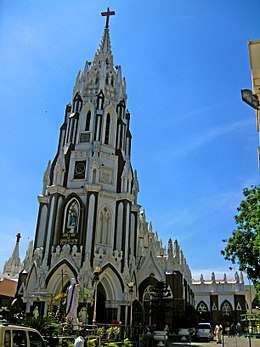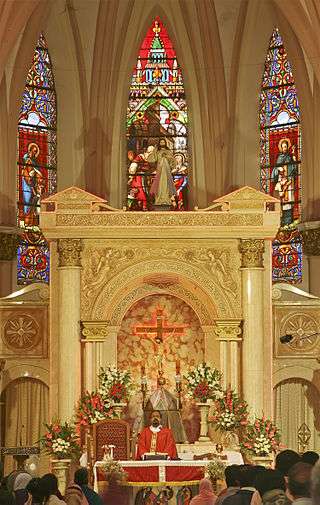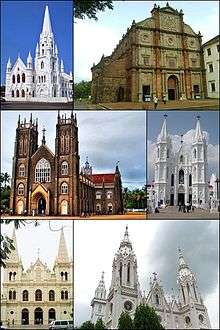St. Mary's Basilica, Bangalore
| St. Mary's Basilica | |
|---|---|
| செயின்ட் மேரிஸ் பசிலிக்கா / ಸೇಂಟ್ ಮೇರಿಸ್ ಬೆಸಿಲಿಕಾ | |
 | |
| Location | Bangalore, Karnataka |
| Country | India |
| Denomination | Roman Catholic |
| Website | www.stmarysbasilica.in |
| History | |
| Status | Minor Basilica |
| Dedication | St. Mary |
| Consecrated | 8 September 1882 |
| Architecture | |
| Functional status | Active |
| Style | Gothic |
| Clergy | |
| Archbishop | Abp. Bernard Moras |
| Rector |
Arulappa Antony Peter |
| Priest(s) | A.S. Anthony Swamy |
| Assistant priest(s) | Deva Dass |
St. Mary's Basilica is located in the Archdiocese of Bangalore in the Indian state of Karnataka. It is among the oldest churches in Bangalore and the first church in the state that has been elevated to the status of a minor basilica.[1][2][3] It is famous for festivities held during the St. Mary's Feast in the month of September each year, attracting devotees from the entire region of Bangalore.
History
St. Mary's Basilica had a humble beginning as a thatched hut in the 17th century, built by Tamil Christian migrants from Gingee. The Shrine was then known as 'Chapel of Kanikkai Madha' and was located in their village where rice was grown. The rice grown in the village had a distinct white colour, and hence the settlement came to known as Bili Akki Palli or colloquially known as ‘‘Blackpally’’ (now known as Shivajinagar).[4] However, according to prominent historian S K Aruni, Blackpally could have been named after John Blakiston (1785-1867), who designed the layout of the Bangalore Cantonment.[5]
Bangalore was not a big city in 1648 when Christianity entered Srirangapattana, the capital city of the then Mysore province. But during Hyder Ali's tenure in 1724-25, Bangalore saw its first Church, Drummers' Chapel, in the Kalasipalya locality. When Tippu Sultan ascended the throne, Christian missionaries had to flee Mysore; thus the history of Christianity in Mysore was murky till 1799. In that year the British seized Srirangapattana from Tipu Sultan. The French MEP priest Jean-Antoine Dubois arrived at Bangalore and began restoring the Catholic religion. He went around Somanahalli, Kamanahalli, Begur, Gunjam, Palahalli, Doranahalli, Garenahalli, Shettyhalli, and beyond, visiting the Catholic families there and ministering to their spiritual needs. He was one of the first to introduce vaccination into India; he also wrote the famous book Hindu Manners, Customs and Ceremonies.[6] The Mass vestments worn by Fr. Jean-Antoine Dubois are still preserved in the church at Palahalli near Srirangapattana.
Dubois built a chapel with a thatched roof in 1803 at Bili Akki Palli, or colloquially Blackpally and offered Mass there.[7] The structure was called Kaanike Mathe Devalaya, which in Kannada means the Church of Our Lady of the Presentation. That small prayer house is the location where the basilica currently stands. When Bangalore Cantonment was established, a Mass was regularly held by Dubois and attended by both European and Indian Catholics. In 1811 Dubois built a small chapel with a rectory for priests. In 1813, with the help of the British, he modified and enhanced the chapel and renamed it the Church of the Purification of Our Lady, Blackpalli. Until recently the engraving of the year '1813' was seen in the front nave of the old church where the miraculous statue is housed.
Fr. Andreas, a priest from Pondicherry of Indian origin, succeeded Dubois and expanded the church building in the shape of a cross. But it was destroyed during the communal riots of 1832, and troops had to be called in to protect the settlement for many months.[1][4][8][9]
The church was rebuilt during the years 1856–1882 under its original name, the Church of our Lady of the Presentation. The current form of the majestic Gothic-style church (pictured) is credited to Rev. L. E. Kleiner. It was consecrated on 8 September 1882 by Bishop Jean-Yves-Marie Coadou, the Vicar Apostolic of Mysore, in the presence of 35 priests and 4,000 Catholics of Bangalore. The total amount spent on the construction of the new church. including the pulpit and the statues, was Rs. 29,659.
Over time, the church of St. Mary's at Blackpally had become a parish and has since overseen the construction of other churches in Bangalore, most prominently St. Francis Xavier's Cathedral (1851), St. Joseph's Church (1867), and Sacred Heart Church, Ashoknagar (1867). The church was elevated to the status of a minor basilica in 1973 through an edict issued by Pope Paul VI. It was the sixth church in India to be elevated to this status. An annual nine-day Novena is held between 30 August and 7 September, with Mass being offered in English, Kannada, and Tamil.[4] The area of Blackpally is now known as Shivajinagar.
Architecture

The basilica has been built in the Gothic style with arches, ornamental motifs, and stained glass windows.[10] Multiple columns with rich Corinthian capitals support the stately arches of the Church. The columns and tall spires of the basilica can be seen from far away. The stained glass windows were removed during World War II and were subsequently restored in 1947.
St. Mary's feast
St. Mary's Feast which celebrates the birth of Mother Mary is the most important festival celebrated in the basilica and is attended by 100,000 people. Held in the month of September, the festivities go on for 10 days culminating in a grand chariot procession on the last day.[7] The festivities begin with the hoisting of a traditional flag. A Novena is held on the first nine days from 29 August to 7 September. September 8, the day on which Mother Mary was born, is celebrated as a Holy feast. Mass is offered in different languages and mass marriages are conducted for the poor and needy. A thanksgiving Mass is also organized for couples who have completed 50 years of marriage. Eucharistic celebrations are held on the day of the feast and a decorated chariot with the image of Mother Mary is drawn by devotees along the various streets of Bangalore.
Mass times
| Weekdays | Saturday | Sunday |
|---|---|---|
|
06:00 English |
06:00 English |
06:00 English |
 The church
The church Nave
Nave Altar
Altar Front view from the road
Front view from the road Pillars inside the church
Pillars inside the church Church gate
Church gate At night
At night
Notes
- 1 2 Chandramouli, K (29 August 2002). "Home to all faiths" (Bangalore). The Hindu. Retrieved 7 January 2015.
- ↑ Sharma, Preethi; Vishwanathan, Nishi. Bangalore:An Expat Survival Guide. Chillibreeze publication. Retrieved 2007-08-15.
- ↑ Srinivas, Smriti (2001). Landscapes of Urban Memory: The Sacred and the Civic in India's High-Tech City. Minneapolis: University of Minnesota Press. p. 18. ISBN 1452904898. Retrieved 19 January 2015.
- 1 2 3 St. Mary's Basilica. "St. Mary's Basilica - History". St. Mary's Basilica.
- ↑ Aruni, S K (29 February 2012). "Tracing the architect of the Cantonment" (Bangalore). The Hindu. Retrieved 19 January 2015.
- ↑ Dubois, J. A. (Jean Antoine); Beauchamp, Henry K. (Henry King); Dubois, J. A. (Jean Antoine) (1906). Hindu manners, customs and ceremonies. Oxford : Clarendon Press.
- 1 2 "Annual St. Mary's Feast begins". Online Edition of The Hindu, dated 2006-08-30. Chennai, India. 2006-08-30. Retrieved 2007-08-15.
- ↑ Preethi Sharma; Nishi Vishwanathan. Bangalore:An Expat Survival Guide. Chillibreeze publication. ISBN 978-81-904055-2-2. Retrieved 2009-03-20.
- ↑ "Annual St. Mary's Feast begins". Online Edition of The Hindu. Chennai, India. 2006-08-30. Retrieved 2009-03-20.
- ↑ Anita Rao Kashi (2005-10-16). "Blessing faithful, soothing the eye". Online Edition of The Times of India, dated 2005-10-16. Times Internet Limited. Retrieved 2007-08-16.
Coordinates: 12°59′3.1″N 77°36′13.99″E / 12.984194°N 77.6038861°E
External links
| Wikimedia Commons has media related to St. Mary's Basilica, Bangalore. |
